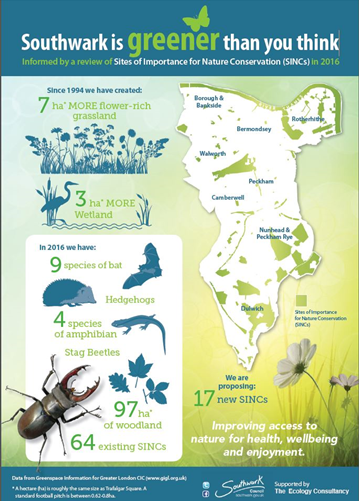Ecology
Park users will notice that we have relaxed grass mowing in some areas of our parks. For example, around the edges of our parks, under trees and perhaps in existing conservation areas as well. If you look closely you will see a greater diversity in wildflowers already. But, over time, and with a little careful management, we hope to see even more wildflowers blooming in these spaces. These will encourage more bees, butterflies and other local wildlife as well.
However, we understand that our parks play many roles for many people, and we have been careful to balance these new changes and ensure that there is still plenty of space for people to relax, have picnics, play sports and enjoy the outdoors. We can reassure you that we will continue to maintain plenty of grassed areas for this to continue as well.

Southwark is a rich ecological resource with its parks and open spaces home to various species of birds, fish, mammals, wildflowers and invertebrates. There are 65 sites of importance for nature conservation in Southwark including 7 local nature reserves.
Key habitats of ecological importance
- woodland (ancient and secondary)
- meadows
- parks and urban greenspace, including churchyards and cemeteries
- reedbeds
- standing water, including ponds, lakes and docks
- rivers and streams
- built environment
- brownfield
- private gardens
- wildlife corridors
- scrubland
- deadwood
National or regional Biodiversity Action Plan species
- stag beetle
- common lizard
- slow-worm
- hedgehog
- common frog
- common toad
- smooth newt
- red-eyed damselfly
- European eel
- black poplar
- mistletoe
- cornflower
- white-letter hairstreak
Page last updated: 03 October 2024
